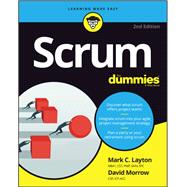Use scrum in all aspects of life
Scrum is an agile project management framework that allows for flexibility and collaboration to be a part of your workflow. Primarily used by software developers, scrum can be used across many job functions and industries. Scrum can also be used in your personal life to help you plan for retirement, a trip, or even a wedding or other big event.
Scrum provides a small set of rules that create just enough structure for teams to be able to focus their innovation on solving what might otherwise be an insurmountable challenge. Scrum For Dummies shows you how to assemble a scrum taskforce and use it to implement this popular Agile methodology to make projects in your professional and personal life run more smoothly—from start to finish.
- Discover what scrum offers project and product teams
- Integrate scrum into your agile project management strategy
- Plan your retirement or a family reunion using scrum
- Prioritize for releases with sprints
No matter your career path or job title, the principles of scrum are designed to make your life easier. Why not give it a try?








